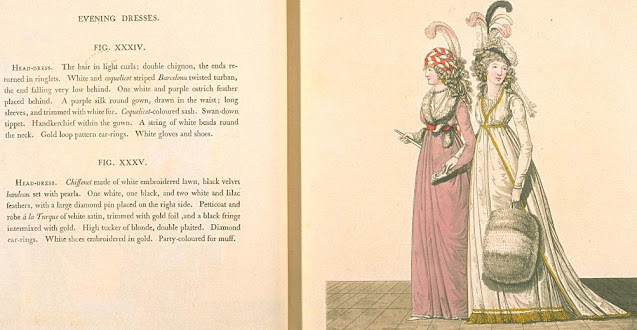 |
| Image courtesy Hannah. Thank you so much! |
- The robe still was a bit loose on me, no matter how tightly the front might be pinned. Must see if alterations needed. I understand that robes were meant to accommodate for changes in weight and bulk: let us experiment some more on what pins can do.
- The goldworked petticoat lacks enough shine. I spaced the motifs on the sparing side. Easy enough to correct: add more!
- Feather headdress needed more securing. I will talk more about that later.
- Our ballroom lacked a traditional anteroom with a mirror, and the ensemble sorely needed a check before entry, because I did not know that the dress lace at the neckline had partly folded underneath, and the feathers needed adjusting. Lesson: find a bathroom and take your time
The Ensemble Inspiration
The ensemble has its roots in several Gallery of Fashion plates extant garments and portraits.
The Robe Inspiration
The robe I actually made last year, although I did not write about it until a September picnic, and you are already aware of the roots of its lace. You may not know, though, that the back of the gown itself has its roots in the same dress, " the silver round gown" from Karen Augusta. As you will see below, I used the same vee cut for the center back as on this gown. It has a wonderfully vertical, narrowing effect entirely lacking in diamond-shaped back pieces.
The petticoat is inspired by two Gallery of Fashion plates and the motifs embroidered on it come from elements of actual 18th century goldwork embroidery in 18th Century Embroidery Techniques.
Figure XLII, the rightmost figure in the February 1795 plate above, wears a gold sprigged and fringed petticoat. Whenever the text refers to "gold", I take it to mean goldwork and "silver" I take to mean goldwork done in silver, which was also very popular. The text, so far as I can tell from unscientific reading, usually calls other embroidery colored or gives specific colors, such as black. It is possible that the term gold means gold-colored silks or cotton, but I suspect that, given how prevalent goldwork was among the bon ton, real gold is meant. For more information, see 18th Century Embroidery Techniques and Napoleon, The Empire of Fashion.
Here below is the other plate, from December 1794; figure 35 is my inspiration.
The Headdress Inspiration
The headdress is taken from a specific figure, no. 37 from January 1795, shown above. It is described thus: "Chiffonet of white satin, two white ostrich feathers, and a large diamond pin placed on the left side."
Robe Construction
The front and lining of each bodice piece treated separately: basted together, the edges turning in.
- Each piece sandwiched with the next to create a lapped seam and backstitch of combination stitched down.
- All edges finished by combination stitching the turned-in seams (but one of seveal ways to do it).
- The sleeves backstitched at the bottom half, then set on a manniquin (which should have been a live person), the shoulder straps laid atop, and stitched down. The insides left unfinished for easier renovation.
- The skirt top turned under, and carefully whipped to the extreme bottom edge of the bodice.
- The skirt hems turned to a small hem and combination stitched, except the bottom hem, which was machined.
For detailed instructions on how to sew in this manner, please refer to the Costuming Research and Documentation page on this blog, where I have links to tutorials.
Above, the lace on the dress.
The dress opened up to show the interior. Note the modesty panels that are sewn to the side seams. When donning the robe, first one panel is wrapped over the stays and pinned there securely, then the other ditto.
Then the robe front pieces are lapped tightly to fit as smoothly as possible. The drawstrings at the top are pulled tight and tied.
Then small pins are inserted horizontally into the edge -- between the fashion fabric and the lining -- of the overlapping piece, and then caught in the underlapped piece. I insert a pin almost every inch. This holds the gown securely closed, invisibly.
Above, how the lace is tacked on. It is easily removable.
How the skirts are attached to the bodice. You can also see the two seams attaching the vee-shaped back piece to the two side back pieces.
The armscye, showing the stitching as well as the basting.
That's it for the robe. Next time, the pettioat, embroidered in gold purl and spangles and pastes!











I totally agree, more gold!!
ReplyDeleteYou bet. The evenings through the next weeks will be spent adding motifs, one at a time...
ReplyDeleteVery best,
Natalie
You look stunning!
ReplyDeleteThank you, Isis!
ReplyDeleteVery best,
Natalie